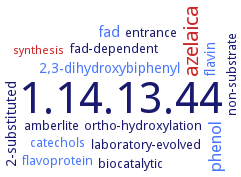1.14.13.44: 2-hydroxybiphenyl 3-monooxygenase
This is an abbreviated version!
For detailed information about 2-hydroxybiphenyl 3-monooxygenase, go to the full flat file.

Word Map on EC 1.14.13.44 
-
1.14.13.44
-
azelaica
-
phenol
-
fad
-
2-substituted
-
flavin
-
2,3-dihydroxybiphenyl
-
biocatalytic
-
non-substrate
-
laboratory-evolved
-
amberlite
-
fad-dependent
-
entrance
-
ortho-hydroxylation
-
flavoprotein
-
catechols
-
synthesis
- 1.14.13.44
- azelaica
- phenol
- fad
-
2-substituted
- flavin
- 2,3-dihydroxybiphenyl
-
biocatalytic
-
non-substrate
-
laboratory-evolved
-
amberlite
-
fad-dependent
-
entrance
-
ortho-hydroxylation
- flavoprotein
- catechols
- synthesis
Reaction
Synonyms
2-hydroxybiphenyl 3-monooxygenase, HBP1, HbpA, oxygenase, 2-hydroxybiphenyl 3-mono-
ECTree
Advanced search results
Engineering
Engineering on EC 1.14.13.44 - 2-hydroxybiphenyl 3-monooxygenase
Please wait a moment until all data is loaded. This message will disappear when all data is loaded.
G255F
the variant exhibits 7% compared to the specific activity of the wild-type enzyme on NADH and 2,3-dihydroxybiphenyl, suggesting inhibition of substrate entrance into the active site by the large aromatic residue
I244V
-
mutant enzyme has a 30% higher specific activity with 2-sec-butylphenol, guaiacol, and 2-hydroxybiphenyl. The Km-value for guaiacol decreases with this mutant, but the Km-value for 2-hydroxybiphenyl increase
M223A
site-directed saturation mutagenesis, the mutant shows reduced activity compared to wild-type enzyme
M223E
site-directed saturation mutagenesis, the mutant shows reduced activity compared to wild-type enzyme
M223I
site-directed saturation mutagenesis, the mutant shows reduced activity compared to wild-type enzyme
M223K
site-directed saturation mutagenesis, the mutant shows reduced activity compared to wild-type enzyme
M223Q
site-directed saturation mutagenesis, the mutant shows reduced activity compared to wild-type enzyme
M321A
site-directed saturation mutagenesis, the mutant variant demonstrates altered regioselectivity by oxidizing 3-hydroxybiphenyl, and thus enabling the production of a distinct antioxidant, 3,4-dihydroxybiphenyl, with similar ferric reducing capacity to the well-studied piceatannol. Mutant enzyme crystal structure analysis and comparison to the wild-type enzyme structure
M321F
site-directed saturation mutagenesis, wild-type HbpA possess pro-S enantioselectivity towards the production of several chiral sulfoxides, whereas the mutant M321F exhibits improved enantioselectivity and increased activity compared to wild-type
M321L
site-directed saturation mutagenesis, the mutant shows reduced activity compared to wild-type enzyme
M321V
site-directed saturation mutagenesis, the mutant shows reduced activity compared to wild-type enzyme
P320X
site-directed mutagenesis, all mutations of Pro320 in the library result in activity loss. Therefore, it appears that a proline at this position is crucial for the catalytic reaction. The short distance of Pro320 from the FAD cofactor implies its involvement in enabling the movement of FAD, which is imperative for HbpA activity. Pro320 is conserved among flavin monooxygenases. In aklavinone-11-hydroxylase (RdmE), para-hydroxybenzoate hydroxylase (pHBH), and phenol hydroxylase (PH), this position next to the FAD is occupied by Pro315, Pro293, and Pro364, respectively
R242A
the variant is not active on NADH and 2,3-dihydroxybiphenyl
R242E
the variant is not active on NADH and 2,3-dihydroxybiphenyl
R242Q
the variant is not active on NADH and 2,3-dihydroxybiphenyl
V368A/L417F
-
double replacement improves the efficiency of substrate hydroxylation by reducing the uncoupled oxidation of NADH. With guaiacol as substrate, the Vmax is increased and the Km-value is decreased. With 2-tert-butylphenol as substrate the turnover number is increased more than 5fold
W225A
the variant exhibits 7% compared to the specific activity of the wild-type enzyme on NADH and 2,3-dihydroxybiphenyl
W225Y
the variant exhibits 122% compared to the specific activity of the wild-type enzyme on NADH and 2,3-dihydroxybiphenyl
W97A
site-directed saturation mutagenesis, the mutant shows reduced activity compared to wild-type enzyme
W97Y
site-directed saturation mutagenesis, the mutant shows reduced activity compared to wild-type enzyme
I244V
-
mutant enzyme has a 30% higher specific activity with 2-sec-butylphenol, guaiacol, and 2-hydroxybiphenyl. The Km-value for guaiacol decreases with this mutant, but the Km-value for 2-hydroxybiphenyl increase
-
V368A/L417F
-
double replacement improves the efficiency of substrate hydroxylation by reducing the uncoupled oxidation of NADH. With guaiacol as substrate, the Vmax is increased and the Km-value is decreased. With 2-tert-butylphenol as substrate the turnover number is increased more than 5fold
-
additional information
-
direct enzyme evolution of EC 1.14.13.44 results in an enzyme variant HbpAind, that hydroxylates indole and indole derivatives such as hydroxyindoles and 5-bromoindole. The wild-type protein does not catalyze theses reactions. HbpAind contains amino acid substitutions D222V and V368A. The activity for indole hydroxylation is increased 18fold in this variant
additional information
site-directed saturation mutagenesis of HbpA and library screening, altering 2-hydroxybiphenyl 3-monooxygenase regioselectivity by protein engineering for the production of a new antioxidant. Modulation of the enzyme activity and selectivity via mutation of several residues in the active site pocket
additional information
-
direct enzyme evolution of EC 1.14.13.44 results in an enzyme variant HbpAind, that hydroxylates indole and indole derivatives such as hydroxyindoles and 5-bromoindole. The wild-type protein does not catalyze theses reactions. HbpAind contains amino acid substitutions D222V and V368A. The activity for indole hydroxylation is increased 18fold in this variant
-


 results (
results ( results (
results ( top
top






